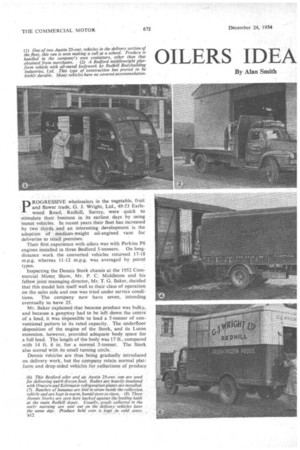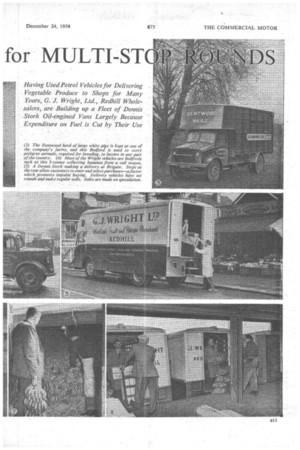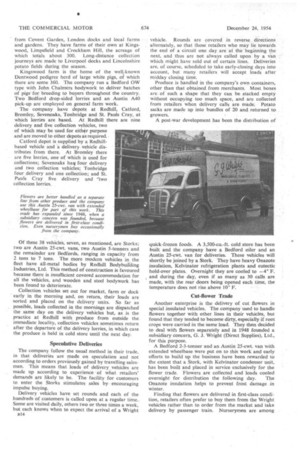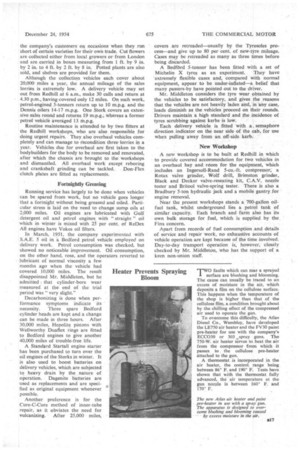OILERS IDEA for MULTI-ST
Page 38

Page 39

Page 40

Page 43

If you've noticed an error in this article please click here to report it so we can fix it.
By Alan Smith
-ROGRESSIVE wholesalers in the vegetable, fruit
• and flower trade, -G. J. Wright, Ltd., 49-53 Earlswood Road, .. Redhill, Surrey, were quick to -stimulate their business in its earliest days by using motor vehicles. In recent years their fleet has.increased by two .thircls and an interesting development is the adoption of medium-weight oil-engined vans for
deliveries to retail premises. . Their fliSt,experience with oilers was with Perkins P6 engines installed in three Bedford 5-tonners. On longdistance work the converted vehicles returned 17-18 m.p.g. whereas 11-12 m.p.g. was averaged by petrol types.
inspectingthe Dennis Stork chassis at the 1952 Com mercial Motor Show, Mr. P. C. Middleton and his fellow joint managing director, Mr. T. G. Baker, decided that this model lent itself well to their class of operation on the sales side and one was 'tried under service conditions. The company now have seven, intending eventually to have 25.
Mr. Baker explained that because produce was bulky,
and because .a gangway had to. be left •down the centre of a load, it was impossible to load a 5-tonner of conventional pattern to its rated capacity. The underfloor disposition of the engine of the -Stork, and its Luton extension, however, provided adequate body _space for a full lead. The length of the body was 17 ft., compared with 14 ft. 6 "in. for a. normal. 5-tonner. The Stork also scored with its smail.ttiming circle. .
Dennis' vehicles are thus. ,being . gradually introduced on delivery work, but the company retain normal plat-. form and. drop-sided vehicles for collections of produce from Covent Garden, London docks and local farms and gardens. They have farms of their own at Kingswood, Limpsfield and Crockham Hill, the acreage of which totals about 300. Long-distance collection journeys are made to Liverpool docks and Lincolnshire potato fields during the season.
Kingswood farm is the home of the well-known Dentwood pedigree herd of large white pigs, of which there are some 360. The company run a Bedford OW type with John Chalmers bodywork to deliver batches of pigs for breeding to buyers throughout the country. Two Bedford drop-sided lorries and an Austin A40 pick-up are employed on general farm work.
The company have depots at Redhill, Catford, Bromley, Sevenoaks, Tonbridge and St. PauIs Cray, at which lorries are based. At Redhill there are nine delivery and five collection vehicles, two of which may be used for either purpose and are moved to other depots as required..
Catford depot is supplied by a Redhillbased vehicle and a delivery vehicle distributes from there. At Bromley there are five lorries, one of which is used for collections; Sevenoaks ha si four delivery and two collection vehicles; Tonbridge four delivery and one collection; and St.
Pauls Cray five delivery and two collection lorries.
Of these 38 vehicles, seven, as mentioned, are Storks; two are Austin 25-cwt. vans, two Austin 5-tonners and the remainder are Bedfords, ranging in capacity from 2 tons to 7 tons. The more modern vehicles in the fleet have all-metal bodies by Redhill Bodybuilding Industries, Ltd. This method of construction is favoured because there is insufficient covered accommodation for all the vehicles, and wooden and steel bodywork has been found to deteriorate.
Collection vehicles set out for market, farm or dock early in the morning and, on return, their toads are sorted and placed on the delivery units. So far as possible, loads collected in the mornings are dispatched the same day on the delivery vehicles but, as is the practice at Redhill with produce from outside the immediate locality, collection vehicles sometimes return after the departure of the delivery lorries, in which case the produce is held in cold store until the next day.
Speculative Deliveries
The company follow the usual method in their trade, in that deliveries are made on speculation and not according to orders previously gained by travelling salesmen. This means that loads of delivery vehicles are made up according to experience of what retailers' demands are likely to be. The facility for customers to enter the Storks stimulates sales by encouraging impulse buying.
Delivery vehicles have set rounds and each of the hundreds of customers is called upon at a regular time. Some are visited daily, others two or three times a week, but each knows when to expect the arrival of a Wright e14 vehicle. Rounds are covered in reverse _ directions alternately, so that those retailers who may lie towards the end of a circuit one day are at thebeginning the next, and thus are not always called upon by a van which might have sold out of certain lines. Deliveries are, of course, scheduled to take early-closing days into account, but many retailers will accept loads after midday closing time.
Produce is handled in the company's own containers, other than that obtained from merchants. Most boxes are of such a shape that they can be stacked empty without occupying too much space, and are collected from retailers when delivery calls are made. Potato sacks are made up into bundles of 20 and returned to growers.
A post-war development has been the distribution of quick-frozen foods. A 3,500-cu.-ft. cold store has been built and the company have a Bedford oiler and an Austin 25-cwt. van for deliveries. These vehicles will shortly be joined by a Stork. They have heavy Onazote insulation, Kelvinator refrigeration plants and eutectic hold-over plates. Overnight they are cooled to —4° F. and during the day, even if as many as 30 calls are made, with the rear doors being opened each time, the temperature does not rise above 10° F.
Cut-dower Trade Another enterprise is the delivery of cut flowers in special insulated vehicles. The company used to handle flowers together with other lines in their vehicles, but found that they tended to become dirty, especially if root crops were carried in the same load. They then decided to deal with flowers separately and in 1948 founded a subsidiary concern, G. J. Wright (Direct Supplies), Ltd., for this purpose.
A Bedford 2-3-tonner and an Austin 25-cwt. van with extended wheelbase were put on to this work and early efforts to build up the business have been rewarded to the extent that a Stork, with Kelvirtator condenser unit, has been built and placed in service exclusively for the flower trade. Flowers are collected and loads cooled overnight for distribution the following day. The Onazote insulation helps to prevent frost damage in winter.
Finding that flowers are delivered in first-class condition, retailers often prefer to buy them from the Wright vehicles rather than to order from the market and take delivery by passenger train. Nurserymen are among the company's customers on occasions when they run short of certain varieties for their own trade. Cut flowers are collected either from local growers or from London and are carried in boxes measuring from 1 ft. by 9 in. by 2 in. to 4 ft. by 2 ft. by 8 in. Potted plants are also sold, and shelves are provided for them.
Although the collection vehicles each cover about 20,000 miles a year, the annual mileage of the sales lorries is extremely low. A delivery vehicle may set out from Redhill at 6 a.m., make 30 calls and return at 4.30 p.m., having covered only 12 miles. On such work, petrol-engined 5-tonners return up to 10 m.p.g. and the Dennis oilers 14-17 m.p.g. One Stork covers an exten"sive sales round and returns 19 m.p.g.; whereas a former petrol vehicle averaged 13 m.p.g.
Routine maintenance is attended. to by two fitters at the Redhill workshops, who are also responsible for doing urgent repairs. They also overhaul vehicles completely and can manage to recondition three lorries in a year. Vehicles due for overhaul are first taken to the bodybuilders for the body to be removed and renovated, after which the chassis are brought to the workshops and dismantled. All overhaul work except reboring and crankshaft grinding can be tackled. Don-Flex clutch plates are fitted as replacements.
Fortnightly Greasing
Running service has largely to be done when vehicles can be spared from work, but no vehicle goes longer that a fortnight without being greased and oiled. Particular stress is laid on the need to change sump oils at 2,000 miles. Oil engines are lubricated with Gulf detergent oil and petrol engines with " straight" oil which in winter is mixed with 25 per cent. of ReDex All engines have Vokes oil filters.
In March, 1951, the company experimented with S.A.E. 5 oil in a Bedford petrol vehicle employed on delivery work. Petrol consumption was checked, but showed no noticeable improvement. Oil consumption, on the other hand, rose, and the operators reverted to lubricant of normal viscosity a few months ago when the vehicle had
covered 10,000 miles. The result Heater disappointed Mr. Middleton, but he admitted.. that cylinder-bore wear measured at the end of the trial period was "very slight."
Decarbonizing is done when performance symptoms indicate its necessity. Three spare Bedford cylinder heads are kept and a change cart be made in three hours. After 30,000 miles, Hepolite pistons with Wellworthy Duaflex rings are fitted to Bedford engines to give another 40,000 miles of trouble-free life.
A Standard Startall engine starter has been purchased to turn over the oil engines of the Storks in winter. It is also used to boost batteries on delivery vehicles, which are subjected to heavy drain by the nature of operation. • Dagenite batteries are used as replacements and are specified as original equipment whenever possible.
Another preference is for the Cure-C-Cure method of inner-tube repair, as it obviates the need for vulcanizing. After 25,000 miles, covers are retreaded—usually by the Ty-resoles process—and give up to 80 per cent. of new-tyre mileage. Cases may be retreaded as many as three times before being discarded.
A Bedford 5-tonner has been fitted with a set of Michelin X tyres as an experiment. They have -extremely flexible cases and, compared with normal equipment, appear to be under-inflated—a belief that many passers-by have pointed out to the driver.
Mr. Middleton considers the tyre wear obtained by the vehicles to be satisfactory, and gives the reasons that the vehicles are not heavily laden and, in any case, loads diminish as the vehicles proceed on their rounds. Drivers maintain a high standard and the incidence of tyres scrubbing against kerbs is low. "
Each delivery vehicle is fitted with a. semaphore direction indicator on the near side of the cab, for use when pulling away from an. off-side kerb.
New Workshop A new workshop is to be built at Redhill in which to provide, covered accommodation for two vehicles in an overhaul bay and room for the equipment, 'which includes an Ingersoll-Rand 5-cu.-ft. compressor; a Rotax valve grinder, Wolf drill, Brimston grinder, Black and Decker valve-reseating kit, C.A.V. nozzle tester and Britool valve-spring tester. There is also a Bradbury 5-ton hydraulic jack and a mobile gantry for engine removal.
Near the present workshops stands a 700-gallon oilfuel tank, whilst underground lies a petrol tank of similar capacity. Each branch and farm also has its own bulk storage for fuel, which is supplied by the Fina concern.
Apart from records of fuel consumption and details of service and repair "work, no exhaustive accounts of vehicle operation are kept because of the time involved. Day-to-day transport operation is, however, closely checked by Mr. Middleton, who has the support of a keen non-union staff.












































































